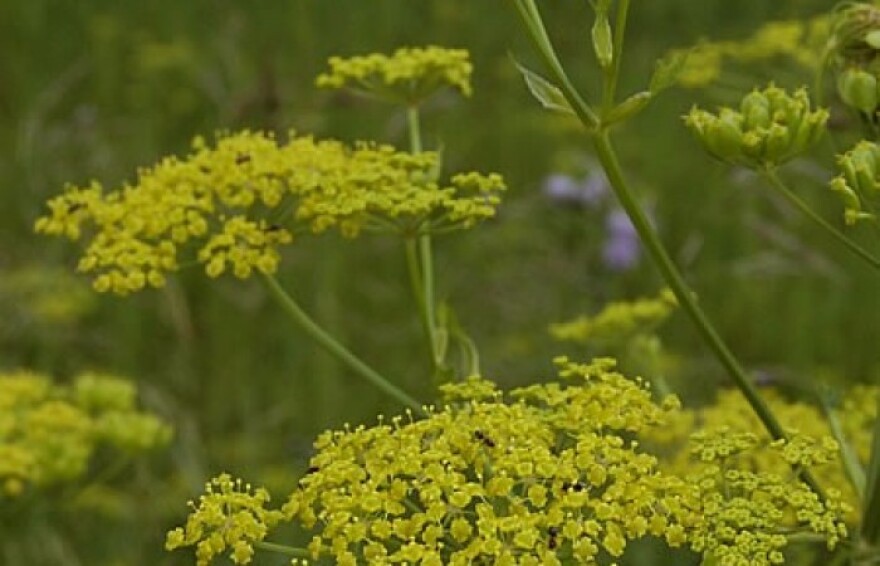Dogs are extremely good at sniffing things out. Mequon Nature Preserve decided to take advantage of the canine skill and brought on Tilia, the first on-staff conservation dog in Wisconsin.

One of her trainers is Kathy Hatch. The day I visited, she had been busy hiding several plants amidst tall grasses outside the preserve.
The plant is an invasive one, called wild parsnip. It is nasty - not only does it spread and crowd out native species - but be you animal or human, come into contact with its sap, and you can suffer serious burns.
Tilia is learning to find, but not touch, the wild parsnip.
Hatch works with Tilia two days a week and says the work is exhausting for the dog.
Cory Gritzmacher with Mequon Nature Preserve commiserates. Hatch also is training him - so he can work with Tilia as her handler.
“There’s many days I go home after training my brain hurts a little bit, because it’s not just trying to figure out the dog to go sniff out in the weeds and find a plant, there’s definitely a science behind it, without a doubt,” Gritzmacher says.
Tilia, wearing her official blue work vest, romps off onto the nature preserve grounds, southeast of the City of Mequon with Gritzmacher in tow.

Hatch closely watches the team at work. “He’s going to watch the way her nose goes, the way her head turns and he’s going to follow the dog. And he’s going to be moving in a way that supports the dog, but doesn’t help the dog…..see how she turned,” she says.
Dogs don’t usually make sharp turns like this, the trainer says, unless there’s a reason. Hatch says Tilia must have smelled something. Turns out, the trainee was temporarily distracted by some deer poop.

Tilia bounds off in a new direction and this time sniffs out one of the parsnip plants Hatch had hidden. This time, the dog responds exactly as she was trained.
“They put their nose near it, and then they will stay in one place and look for the handler, so they’re waiting….see how she did that? So they’re looking for their cookie or their toy reward to say yes you’re right. But the handler has to check out did your really get it, is that what we’re looking for? Oh good job,” Hatch says.
Dogs are good at finding invasive species because their sniffing power far surpasses mere human’s ability to see where the plants are popping up. Then people can remove them.
Hatch says one day Cory Gritzmacher will be able to remove the leash and Tilia will stay on task, for instance, even if she sees a deer.
“She will be so focused on her target odor that she will acknowledge there is a deer there but not care because I’m working for either salamanders or wild parsnip,” she says.

Mequon Nature Preserve is putting as much energy into ridding its landscape of wild parsnip as it is in encouraging salamanders to thrive here.
Over the last few years, the preserve has been transferring two native species - blue-spotted and Eastern tiger - from nearby healthy populations, hoping they will thrive on the preserve property.
Trainer Kathy Hatch says Tilia’s sniffing potential is boundless. “If it has an odor, the dog can be trained on it,” she says.
But down time is also important. After her 20 minute workout, Tilia heads back indoors to chill. Hatch calls that a valuable component of her training.
“It’s called latent learning and so while she’s resting, she’s actually processing everything that went down out there,” she says.
Tilia will also enjoy time away from the job. She’ll spend nights and weekends with the nature preserve’s director and her family.
Tilia may be Wisconsin’s first on-staff conservation dog, but Pete Coppolillo predicts she won’t be the last. He heads Working Dogs for Conservation, a Montana-based organization founded in 1995.
“I think in 10 years’ time virtually every nature preserve, federal agencies, state land management agencies, they’ll have their own dog teams because they’re so cost effective and they’re so good a what they do. So, I think they’re ahead of the curve,” Collolillo says.
And, he adds, dogs are the perfect outreach tool. A friendly pooch sniffing out an invasive plant draws far more oohs and aahs than a human any day.
Tilia recently celebrated her first birthday and will complete her conservation training by the end of the year. Another trainer will work with her so that when busloads of school children arrive to spend time at Mequon Nature Preserve, Tilia will be able to officially greet them.
Her Mequon Nature Preserve partner Cory Grizmacher says, “The idea is to have her roam the hallways – be a loving dog to the kids and showcase her field work.”






